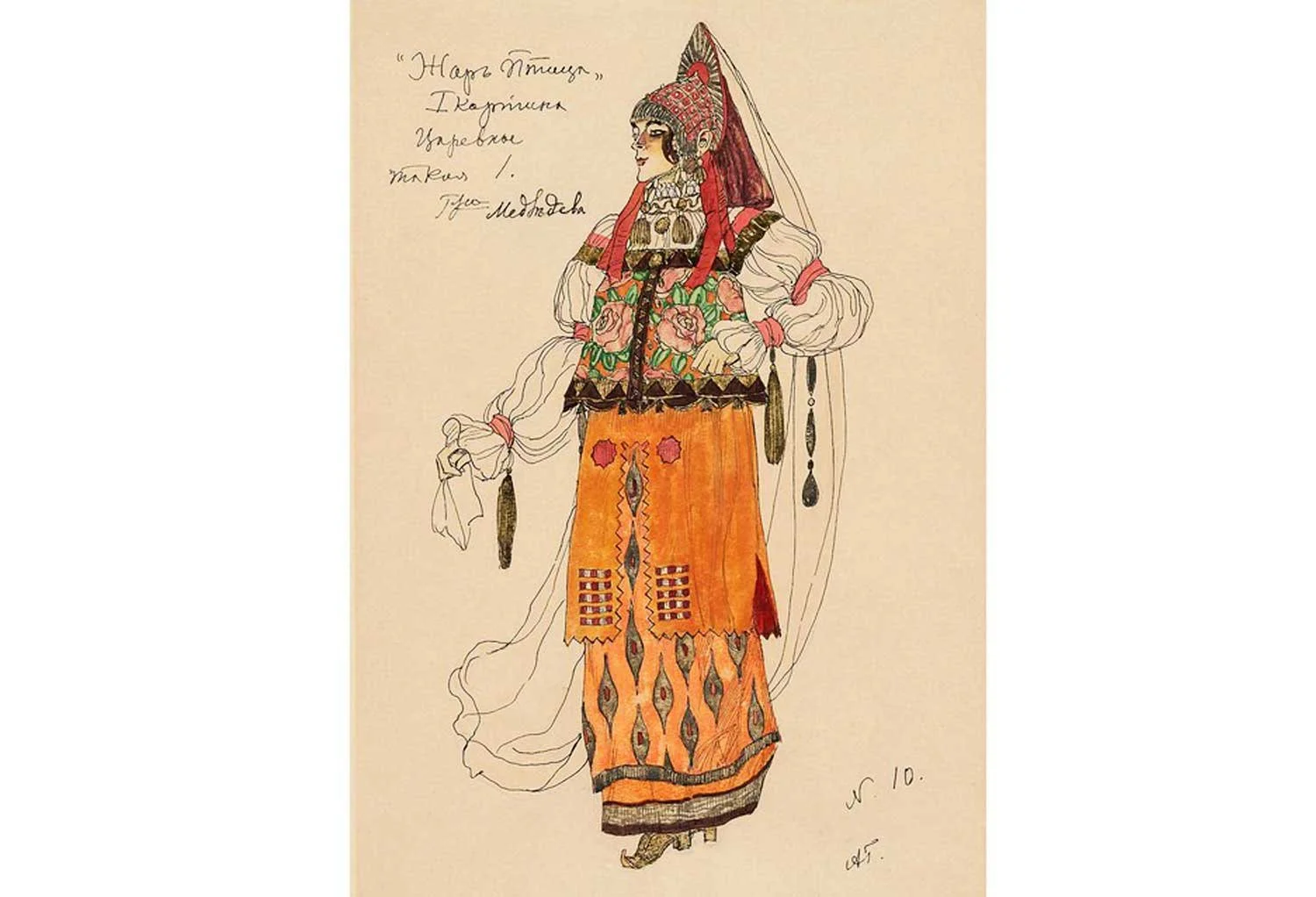The Design of Les Ballets Russes
“Ah, Les Ballets Russes—a kaleidoscope of color, movement, and avant-garde design! ”
Their costume designs were some of the most revolutionary and sumptuous the dance world has ever seen. Below is a collected dossier, for Far London, detailing their history, design principles, and the colors, materials, and stylistic innovations that defined their look.
In History…
Active: 1909–1929
Founder: Sergei Diaghilev, Russian impresario and visionary
Base: Though Russian in spirit, Les Ballets Russes was based in Paris, with no official home stage in Russia.
Les Ballets Russes was a pioneering dance company that brought together some of the most extraordinary minds in art, music, and design. Diaghilev’s goal was not merely to stage a ballet, but to orchestrate a total work of art (a Gesamtkunstwerk), combining modernist music, radical choreography, expressive costume, and theatrical set design.
Vaslav Nijinsky was a choreographer and possibly the most famous male dancer of the 20th c. from Wiki
Main collaborators included:
Composers: Igor Stravinsky, Claude Debussy, Erik Satie, Maurice Ravel
Choreographers: Michel Fokine, Vaslav Nijinsky, Léonide Massine, George Balanchine
Designers/Artists: Léon Bakst, Alexandre Benois, Natalia Goncharova, Pablo Picasso, Henri Matisse
Dancers: Vaslav Nijinsky, Anna Pavlova, Leonide Massine, Mikhail Fokine, Serge Lifar, and many others.
Léon Bakst was one of the most famous costume designers in ballet and theatre. NYPL collection.
Costume and Color
The color palettes of Les Ballets Russes were anything but restrained. Inspired by Orientalism, Russian folk art, Cubism, and Art Nouveau, the hues used were decadent, jewel-toned, and highly symbolic.
From my notebook of colors and styles
Signature Theme Palettes:
Deep jewel tones: ruby red, sapphire blue, emerald green, amethyst purple
Orientalist golds and rich browns: opulent tones to evoke exotic, Eastern settings
Psychedelic brights: hot pinks, oranges, turquoise, acid green (especially in the later Goncharova works)
Metallic threads: gold and silver were used to catch the stage lights
Contrasting motifs: Black and white geometric designs against bright primaries in Cubist costumes
Colors were not only decorative—they were also narrative and emotional, often matching the psychological tone or mythological reference of the ballet.
Costume Materials:
Costumes were lush, textured, and unconventional, reflecting a break from the classical tutu and pointe shoe aesthetic.
Silk (painted, dyed, pleated)
Velvet and wool
Gold lame and brocade
Sequins, beads, fringe, and tassels
Appliqué work and metallic embroidery
Layered gauze and chiffon for ethereal effects
Heavy costume jewelry for dramatic flair
Designs often drew on Russian peasant dress, Byzantine mosaics, Persian miniatures, and Japanese kimono forms.
Design Style and Influences:
Costumes for Les Ballets Russes were not static fashion; they were built for movement, theatricality, and illusion.
Identifying features:
Voluminous silhouettes (especially in Schéhérazade and The Firebird)
Exaggerated shapes and layers (robes, turbans, exaggerated shoulders)
Graphic patterning: swirling lines, stylized foliage, geometric abstraction
Masks and headpieces often influenced by commedia dell’arte, African sculpture, or Slavic folklore
Cubist and Futurist designs (especially in Parade, with Picasso, and Le Soleil de Nuit)
Ballets Russes ‘Le Coq D’Or’ in 1914, peasant girl costume by Natalia Goncharova, C. Tate Modern 2025
Influential Designers:
Léon Bakst – arguably the most iconic costume designer; known for his opulent Orientalism and bold prints
Natalia Goncharova – pioneered folk-modernist hybrids, often using Russian iconography and vibrant palettes
Pablo Picasso – introduced Cubism into stage design (Parade, 1917)
Henri Matisse – brought in Fauvist color and flattened, decorative motifs
Famed Ballets and Coordinated Costumes:
Schéhérazade (1910)
Lavish, Middle Eastern fantasy
Costumes rich in purples, golds, crimsons
Heavy silks, embellished harem pants, veils, turbans
Bakst’s hallmark of “decadent Orientalism”
Costume for ‘L'Oiseau de feu’ (Firebird), by Alexander Golovin
The Firebird (1910)
Designed by Bakst and Alexander Golovin
Costumes included flame-like reds and oranges, feathered headdresses, and shimmering fabrics
A blend of Slavic folklore and magical fantasy
Petrushka (1911)
Costumes by Benois
Set in a Russian fairground with folk-inspired patchwork and puppet motifs
Clownish palette: red cheeks, black-and-white checkers, bold blues
The Rite of Spring (1913)
Radical choreography and raw costumes by Roerich
Earth tones, tribal shapes, fringe, and primitive silhouettes
Based on pagan ritual—shockingly non-balletic at the time
Parade (1917)
Designed by Picasso
Costumes resembled Cubist cardboard sculptures
Movement-restricting, geometric, intentionally absurd
A blend of circus, Surrealism, and satire
Lasting Influence:
The influence of Les Ballets Russes on fashion, modernist art, and theatre design cannot be overstated.
Poiret and Chanel drew directly from their aesthetic.
Art Deco owes much to their bold geometry and color.
Their costuming created new dialogues between art, design, and performance.
They redefined dancewear, pushing boundaries of what dancers wore and how costumes could enhance, obstruct, or symbolize character and movement.
Where to learn more:








